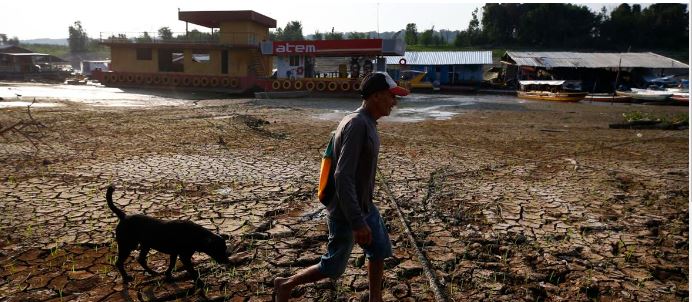
Oct. 10: Communities dependent on the Amazon rainforest's waterways are stranded without supply of fuel, food or filtered water. Dozens of river dolphins perished and washed up on shore. And thousands of lifeless fish float on the water's surface.
These are just the first grim visions of extreme drought sweeping across Brazil's Amazon. The historically low water levels have affected hundreds of thousands of people and wildlife and, with experts predicting the drought could last until early 2024, the problems stand to intensify.
Raimundo Silva do Carmo, 67, makes his living as a fisherman, but these days has been struggling to simply find water. Like most rural residents in Brazil's Amazon, do Carmo typically retrieves water untreated from the biome's abundant waterways. On Thursday morning, he was making his fourth trip of the day to fill a plastic bucket from a well dug into the cracked bed of Lake Puraquequara, just east of Amazonas state's capital Manaus.
"It's dreadful work, even more so when the sun is hot," do Carmo told The Associated Press. "We use the water to drink, to bathe, to cook. Without water, there is no life."
Joaquim Mendes da Silva, a 73-year-old ship carpenter who has lived by the same lake for 43 years, said this drought is the worst he can recall. Area children stopped going to school a month ago because getting there by river became impossible.
Eight Brazilian states recorded the lowest rainfall in the period from July to September in over 40 years, according to CEMADEN, Brazil's disaster warning centre. The drought has affected most of the main rivers in the Amazon, the world's largest basin, which accounts for 20% of the planet's fresh water.
And as of Friday, 42 of 62 municipalities in Amazonas had declared a state of emergency. Some 250,000 people have been affected by the drought so far, and that number may double by year's end, according to the state's civil defence authority.
In the Auati-Parana Extractive Reserve, about 450 miles west of Lake Puraquequara, over 300 riverine families are struggling to get food and other supplies. Only small canoes with reduced cargo can manage the trip to the closest city, and picking a route through shallow water has pushed travel time from nine hours to 14. Moreover, canals to the lakes where they fish for pirarucu, the Amazon's largest fish and their primary source of income, have dried up, and carrying fish that weigh as much as 200 kilograms (about 440 pounds) along trails would be extremely burdensome.
"We run the risk of catching fish in the lake, and it arrives spoiled. So there is no way for us to fish," said Edvaldo de Lira, the local association president.
Dry spells are part of the Amazon's cyclical weather pattern, with lighter rainfall from May to October for most of the rainforest. That already low rainfall is being further reduced this year by two climate phenomena: El Niño — the natural warming of surface waters in the Equatorial Pacific region — and the warming of northern tropical Atlantic Ocean waters, said Ana Paula Cunha, a CEMADEN researcher.












